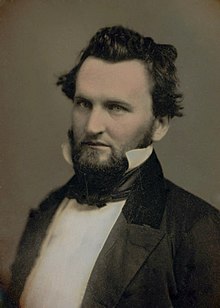J. Neely Johnson
J. Neely Johnson | |
|---|---|
 | |
| 4th Governor of California | |
| In office January 9, 1856 – January 8, 1858 | |
| Lieutenant | Robert M. Anderson |
| Preceded by | John Bigler |
| Succeeded by | John B. Weller |
| Personal details | |
| Born | August 2, 1825 Salt Lake City, Utah Territory |
| Political party | Whig Party, American Party |
| Spouse | Mary Zabriskie |
| Children |
|
| Profession | Jurist, lawyer, politician |
| Signature |  |
John Neely Johnson (August 2, 1825 – August 31, 1872) was an American lawyer and politician. He was elected as the
Biography
Born in rural Gibson County, Indiana, Johnson never attended University; while born to a prominent family, his plans for his studies were foiled by economic effects of the Panic of 1837. He apprenticed a printer before moving to Iowa to work with a lawyer, and was admitted to practice law in Iowa.[2]
In July 1849, Johnson left Iowa for the
During his time in the Assembly, Johnson nearly broke a local editor's nose after accusing the editor of writing an insulting article about him. The editor aimed a pistol at Johnson, but was tackled by onlookers before he could fire.[5]
In 1854, both the state and federal wings of the Whig Party were on the verge on collapse due to party splits over the Kansas–Nebraska Act. In the wake of this split, Johnson joined the nativist American Party, known popularly as the Know Nothings.[citation needed]
In the
Along with the governorship, Know Nothings also received considerable gains in the
Governor
Johnson was sworn in as the fourth
The Vigilante Committee
Since the early 1850s, tensions within
Distrust of city authorities again reached the surface on May 14, 1856, when
Johnson traveled to San Francisco from Sacramento along with his brother William and the newly commissioned chief of the California Militia, Major General William Tecumseh Sherman to meet the Vigilante Committee ringleaders. Sherman recalled in his 1875 Memoirs Johnson angrily confronting Coleman and other Vigilante ringleaders in their makeshift headquarters and exclaiming, "Coleman, what the devil is the matter here?" Coleman replied that the San Franciscans "were tired of it, and had no faith in the officers of the law."[10] After personal negotiations between Governor Johnson and the Vigilantes over transferring the criminals to state law enforcement failed, Johnson watched helplessly as both Casey and Cora were hanged by the Vigilantes on May 20.

Johnson returned to Sacramento with the Vigilantes refusing to disperse, claiming they were San Francisco's rightful law enforcement. With the city's
The Vigilantes remained San Francisco's de facto law enforcement until August 1856. Vigilantes arrested Chief Justice David S. Terry of the Supreme Court of California for stabbing a Vigilante member, and hanged two more individuals. Governor Johnson revoked his proclamation on San Francisco's insurrection on November 3.[14]
Rest of term
The Vigilante Crisis in the summer of 1856 overshadowed the rest of Johnson's term. Despite the fact that a large portion of the
Nevada
Frustrated by his tenure in the California governorship and anxious for a new political start, Johnson relocated to western
In 1867,
References
- ^ "The Nevada Supreme Court". Nevada State Library and Archives. Archived from the original on 15 April 2013. Retrieved 17 February 2013.
- ^ Melendy and Gilbert. The Governors of California: From Peter H. Burnett to Edmund G. Brown, Talisman Press, 1965.
- ^ James P. Jackson (1999). "Celebrating the Sesquicentennial of the Sacramento City Attorney's Office" (PDF). City of Sacramento. Archived from the original (.PDF) on 2007-06-20. Retrieved 2007-05-10.
{{cite journal}}: Cite journal requires|journal=(help) - ^ "J. Neely Johnson Candidate Biography". JoinCalifornia. Retrieved 2007-05-10.
- ^ a b c California State Library. "Governor J. Neeley Johnson of California". State of California. Archived from the original on 2007-06-13. Retrieved 2007-05-10.
- ^ "5 September 1855 General Election". JoinCalifornia. Retrieved 2007-05-10.
- ^ Long, Percy Vincent (1912). The Consolidated City and County Government of San Francisco: Read Before the Annual Convention of the American Political Science Association, Held at Buffalo, New York, December 28, 1911. Retrieved 29 November 2022.
- ^ San Francisco (Calif.) (1887). The Consolidation Act and Other Acts Relating to the Government of the City and County of San Francisco. Wm. M. Hinton & Company.
- ^ "The Vigilantes". San Francisco Virtual Museum. Retrieved 2007-05-10.
- ISBN 0-14-043798-3.
- ^ - California Military Museum
- ^ John Wool (5 June 1856). "Letter Governor Johnson". Retrieved 2007-05-21.
- ^ "William Tecumseh Sherman (1820 - 1891)". Museum of the City of San Francisco. Retrieved 2007-05-21.
- OCLC 108243065.
- ^ William C. Miller; Eleanore Bushnell, eds. A.J. Marsh, S.L. Clemens, Amos Bowman. Reports of the 1863 Constitutional Convention of the Territory of Nevada (Carson City: Legislative Counsel Bureau, 1972), p. 465, n18.
- ^ Sacramento Daily Union, vol. 43, no. 6682, 2 September 1872, p.2.

